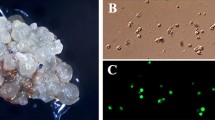Summary
Novel nurse culture methods have been developed for plant regeneration from protoplasts of rice (Oryza sativa). The nurse culture methods use the agarose-bead type culture in combination with actively growing nurse cells that are either in the liquid part of the culture or inside a culture plate insert placed in the centre of the dish. Protoplasts isolated from either primary seed calluses or suspension cultures of various callus origins, divided and formed colonies with a frequency of up to 10% depending on the protoplast source and the genotype. The presence of nurse cells was absolutely required for the induction of protoplast division. Plants were regenerated from protoplast-derived calluses of five tested cultivars with a frequency of 17%–50%. Close examination of the plant regeneration process suggested that plants are regenerated through somatic embryogenesis from protoplast-derived calluses. Over 300 protoplast-derived plants were transferred to either pots or the field and are being examined for karyotypic stability and various plant phenotypes.
Similar content being viewed by others
References
Abe T, Futsuhara Y (1985) Efficient plant regeneration by somatic embryogenesis from root callus tissues of rice (Oryza sativa L.). J Plant Physiol 121: 111–118
Baba A, Hasezawa S, Shono K (1986) Cultivation of rice protoplasts and their transformation mediated by Agrobacterium spheroplasts. Plant Cell Physiol 27: 463–472
Belliard G, Vedel F, Pelletier G (1979) Mitochondrial recombination in cytoplasmic hybrids of Nicotiana tabacum by protoplast fusion. Nature 281: 401–403
Boeshore ML, Lifshitz I, Hanson MR, Izhar S (1983) Novel composition of mitochondrial genomes in Petunia somatic hybrids derived from cytoplasmic male sterile and fertile plants. Mol Gen Genet 190: 459–467
Chu CC, Wang CC, Sun CS, Hsu C, Yin KC, Chu CY, Bi FY (1975) Establishment of an efficient medium for anther culture of rice through comparative experiments on the nitrogen sources. Sci Sin 16: 659–688
Fromm ME, Taylor LP, Walbot V (1986) Stable transformation of maize after gene transfer by electroporation. Nature 319: 791–793
Fujimura T, Sakurai M, Akagi H, Negishi T, Hirose A (1985) Regeneration of rice plants from protoplasts. Plant Tissue Culture Lett 2: 74–75
Harms CT, Potrykus I (1978) Fractionation of plant protoplast types by iso-osmotic density gradient centrifugation. Theor Appl Genet 53: 57–63
Horsch RB, Jones GE (1980) A double filter paper technique for plating cultured plant cells. In Vitro 16: 103–108
Inoue M, Maeda E (1981) Stimulation of shoot bud and plantlet formation in rice callus cultures by two-step culture method using abscisic acid and kinetin. Jpn J Crop Sci 50: 318–322
Kao KN, Michayluk MK (1975) Nutritional requirements for growth of Vinca hajastana cells and protoplasts at a very low population density in liquid media. Planta 126: 105–110
Lörz H, Baker B, Schell J (1985) Gene transfer to cereal cells mediated by protoplast transformation. Mol Gen Genet 199: 178–182
Lu CV, Vasil V, Vasil IK (1981) Isolation and culture of protoplasts of Panicum maximum Jacq. (Guinea Grass): somatic embryogenesis and plantlet formation. Z Pflanzenphysiol 104: 311–318
Medgyesy P, Fejes E, Maliga P (1985) Interspecific chloroplast recombination in a Nicotiana somatic hybrid. Proc Natl Acad Sci USA 82: 6960–6964
Murashige T, Skoog F (1962) A revised medium for rapid growth and bioassays with tobacco tissue cultures. Physiol Plant 15: 473–497
Ohira K, Ojima K, Fujiwara A (1973) Studies on the nutrition of rice cell culture 1. A simple, defined medium for rapid growth in suspension culture. Plant Cell Physiol 14: 1113–1121
Paszkowski J, Shillito RD, Saul M, Mandak V, Hohn T, Hohn B, Potrykus I (1984) Direct gene transfer to plants. EMBO J 3: 2712–2722
Potrykus I, Saul MW, Petruska J, Paszkowski J, Shillito RD (1985) Direct gene transfer to cells of a graminaceous monocot. Mol Gen Genet 199: 183–188
Raghava Ram NV, Nabors MW (1984) Cytokinin-mediated long-term, high frequency plant regeneration in rice tissue cultures. Z Pflanzenphysiol 113: 315–323
Shillito RD, Paszkowski J, Potrykus I (1983) Agarose plating and a bead type culture technique enable and stimulate development of protoplast-derived colonies in a number of plant species. Plant Cell Rep 2: 244–247
Vasil V, Vasil IK (1980) Isolation and culture of protoplasts. 2. Embryogenesis and plantlet formation from protoplasts of Penisetum americanum. Theor Appl Genet 56: 97–99
Wernicke W, Brettel R, Wakizuka T, Potrykus I (1981) Adventitious embryoid and root formation from rice leaves. Z Pflanzenphysiol 103: 361–365
Yamada Y, Yang ZQ, Tang DT (1986) Plant regeneration from protoplast-derived callus of rice (Oryza sativa L.) Plant Cell Rep 4: 85–88
Author information
Authors and Affiliations
Additional information
Communicated by H. Saedler
Rights and permissions
About this article
Cite this article
Kyozuka, J., Hayashi, Y. & Shimamoto, K. High frequency plant regeneration from rice protoplasts by novel nurse culture methods. Mol Gen Genet 206, 408–413 (1987). https://doi.org/10.1007/BF00428879
Received:
Issue Date:
DOI: https://doi.org/10.1007/BF00428879




